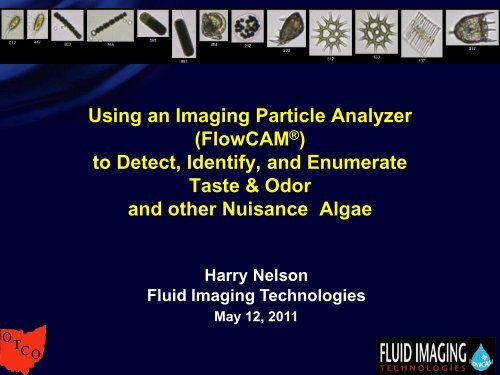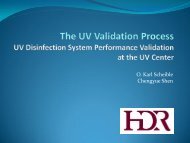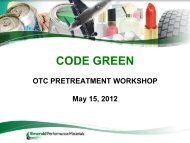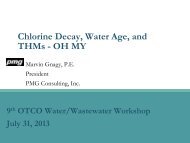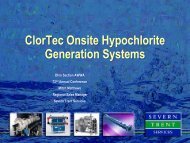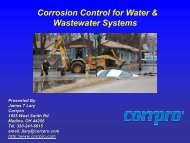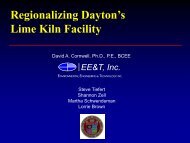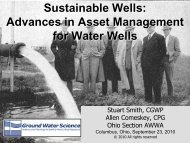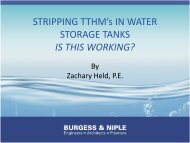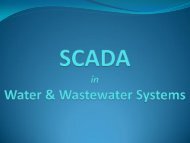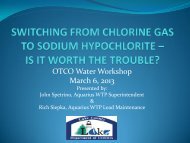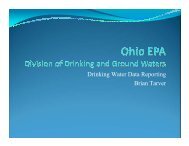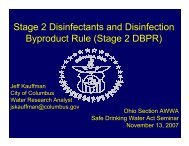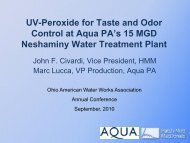Using an Imaging Particle Analyzer - Ohiowater.org
Using an Imaging Particle Analyzer - Ohiowater.org
Using an Imaging Particle Analyzer - Ohiowater.org
Create successful ePaper yourself
Turn your PDF publications into a flip-book with our unique Google optimized e-Paper software.
<strong>Using</strong> <strong>an</strong> <strong>Imaging</strong> <strong>Particle</strong> <strong>Analyzer</strong>(FlowCAM ® )to Detect, Identify, <strong>an</strong>d EnumerateTaste & Odor<strong>an</strong>d other Nuis<strong>an</strong>ce AlgaeHarry NelsonFluid <strong>Imaging</strong> TechnologiesMay 12, 2011
PhotosynthesisExtract & Sequester Carbon
Algae – So What?‣Produce Taste & Odors‣Blooms produce slime/mats, foulingscreens, filters <strong>an</strong>d pumps‣C<strong>an</strong> ch<strong>an</strong>ge aquatic system dynamics‣ C<strong>an</strong> alter pH, alkalinity, color, hardness, turbidity, TOC
Pl<strong>an</strong>kton (Algae)Phytopl<strong>an</strong>kton (Free Floating)PediastrumSynuraAnabaenaCeratiumMicrocystisDinobryon
Major Phytopl<strong>an</strong>kton Taxa‣Chrysophytes (Golden Brown Algae)‣Chlorophytes (Green algae)‣Pyrrophytes (Dinoflagellates)‣Cy<strong>an</strong>ophytes (Blue-Green Algae)‣Bacillariophytes (Diatoms)
Zoopl<strong>an</strong>kton
Periphyton Pl<strong>an</strong>ktonAttached to Substrate
Taste & Odor Causing Algae…Aulacoseira (Waco Water Dist)Ceratium (U.S. EPA)Microcystis (Lake Champlain)Anabaena (Lake Champlain)Mallomonas (Cravins Cove, VA)Tabellaria (Seattle Water Dist)
…Taste & Odor Causing AlgaeAsterionella (S<strong>an</strong> Fr<strong>an</strong>cisco Public Utilities Commission)Volvox (MWRA)Pediastrum (Carvins Cove, VA)Aph<strong>an</strong>izomenon (Lake Champlain)
Filter Fouling Causing AlgaeDeer Creek Reservoir (Utah)Didymosphenia geminata (Chile)Tabellaria (S<strong>an</strong> Fr<strong>an</strong>cisco PUC)Melosira (Schuylkill)
Other Nuis<strong>an</strong>ce Algae‣Anacystis‣Staurastrum‣Uroglenopis‣Synedra‣Synura‣P<strong>an</strong>dorina‣Chlorella‣Hydrodictyon‣Oscillatoria‣Navicula‣Cytocella‣Trachelomonas
Taste & Odor‣ Geosmin‣ Org<strong>an</strong>ic compound (“Earth smell”)‣ MIB (2-methylisoborneol)Both produced by several classes ofmicrobes either when living or whendecomposing
Monitoring for T&O Algae‣ Metabolite Testing‣ Flavor Profile Analysis (FPA)‣ Microscopy Enumeration‣Limitations -‣ Results after-the-fact‣ Results not real-time‣ Labor Intensive‣ Analyze few samples periodically‣ Inconsistent interpretation
Algae Dynamics‣ Dynamic Growth‣ Highly dependent of local environmental conditions‣ Nutrient load, weather conditions, ambient light, temperature‣ Growth often predictable‣ Seasonal‣ Depending on conditions, c<strong>an</strong> be exponentialCourtesy MWRA
Establish Goals, Measure & EvaluateMost Effective – Limit nutrients, etc.Filters, River B<strong>an</strong>k Filtration…Coagulation, flocculation, lyse cellsPotassium permag<strong>an</strong>ate, ClO 2 , OzoneActivated CharcoalPowder Activated Carbon
Fluid <strong>Imaging</strong> Technologies‣ Founded – 1999‣ Maine, USA (BLOS)‣ Flow Cytometer And Microscope(FlowCAM)‣ 300+ FlowCAMs sold‣ Product Development‣ Depth-of-Focus Technology‣ VisualSpreadsheet 2.0, 2.4, 3.0‣ Submersible FlowCAM
FlowCAM ModelsBench TopPortable
FlowCAM ModelsSubmersible FlowCAM
FlowCAM “St<strong>an</strong>dard” ArchitectureSyringePumpSampleComputer
FlowCAM Specifications‣<strong>Particle</strong> sizes –‣ <strong>Imaging</strong> – 3µm to 2mm‣Objectives – 20x, 10x, 4x, 2x‣Flow Cell – 50 µm to 2 mm‣Processing Capability –Flow - .1 ml/min to 12 ml/minDensity - 500,000+ particles/ml (Auto<strong>Imaging</strong>)
FlowCAM Features‣ Continuous <strong>Imaging</strong> (1-20 frames/sec)‣ C<strong>an</strong> be used in laboratory or in-situ‣ Size <strong>an</strong>d shape info for all particles/cells‣ Wide particle size r<strong>an</strong>ge (3 µm to 2 mm)‣ Fluorescence/Scatter Detection/AutoTriggering‣ Image Recognition‣ Automated Identification & Classification
FlowCAM Uses‣ Algae Counts‣ Automatic Taxonomic Identification,Classification, Enumeration <strong>an</strong>d Measurement‣ Uses also in Wastewater Treatment‣ <strong>Particle</strong> Removal Evaluation‣ Training & Education
FlowCAM Users‣ Mass Water Resource Auth (2)‣ New York City DEP (2)‣ Mohawk Valley Water Auth, NY‣ K<strong>an</strong>sas City, MO‣ Veolia Water (Indi<strong>an</strong>apolis, IN)‣ Colorado Springs, CO‣ Westminster, CO‣ Fort Collins, CO‣ Fairfax, VA‣ Tampa, FL‣ Hartford, CT‣ Fairfax, VA‣ Bloomington, IN‣ Tulsa, OK‣ Cheyenne, WY‣ U.S. EPA (2)‣ Siemens (Australia)‣ Singapore Public UtilitiesBoard‣ Institute of HydroEcology(China)‣ Chongqing Inst EnvScience, China (2)
FlowCAM Benefits‣ Rapid algal/particle <strong>an</strong>alysis‣ For use in the field or the lab‣ Objective <strong>an</strong>alysis - Not dependent on skill set orexperience of user‣ Historical records of sample data with images‣ Useful as a training tool“With the automated instrumentation, a single technici<strong>an</strong> c<strong>an</strong> doin minutes what used to take days with a microscope. And wec<strong>an</strong> be more confident in the data when taking action”Betsy Reilly, MWRA
Early Warning Monitoring forT&O AlgaeKelly Kline, Water Quality Analyst, Westminster, CO
St<strong>an</strong>dley Lake Water Supply SystemWestminster, COUpper BigDry CreekWom<strong>an</strong> CreekChurch DitchCroke C<strong>an</strong>alBig DryCreekFarmer’sHigh LineC<strong>an</strong>alClear Creek
What we look at?• Algae Count/Taste <strong>an</strong>d OdorAlgae/Biovolume• Total <strong>Particle</strong> Count (5um-300um).• <strong>Particle</strong>s 5-25 um (small stuff; heterotropic<strong>org</strong><strong>an</strong>isms like ciliates, protozo<strong>an</strong>, <strong>an</strong>dautotrophs like algae).• <strong>Particle</strong>s 25um-300um (algae, ciliates <strong>an</strong>dsome zoopl<strong>an</strong>kton).• Org<strong>an</strong>isms >300um (zoopl<strong>an</strong>kton, algae).
What we do with the information?Lake Report 4/11/11• Increase in algae by 50%since last sampling.• Increase in algaebiovolume by 32%.• Dinobryon population hasdeclined by 24%.• Zoopl<strong>an</strong>kton numbers,particularly large grazershave increase by 25%.Algae is responding toprecipitation event. Nosign of harmful algaespecies.• Bullet reports tostakeholders withalgae <strong>an</strong>d zoopl<strong>an</strong>ktonabund<strong>an</strong>ce (< 24hrs).• Data added to database for trending<strong>an</strong>alysis, forecasting,<strong>an</strong>d graphing.• Lake Journal (Whataffects what).• Archived (Historicalperspectives).
Know Your Lake or Reservoir• Trending <strong>an</strong>alysis (Is this year better or worse th<strong>an</strong> pastyears?)• Cause <strong>an</strong>d effects (If we get x-amount of rain, how doesthe algae respond)?• Ecological Assessment (Are the zoopl<strong>an</strong>kton at a levelthat has controlled algae in the past? Or Why are all thezoopl<strong>an</strong>kton gone?)• When is your lake the most vulnerable? (Different timesof the year are more vulnerable to nutrient inputs th<strong>an</strong>other times).• Early detection sampling will alert you for whensomething is going wrong!
If you don’t measure it, you c<strong>an</strong>’tm<strong>an</strong>age it.
Feasibility Study for Early Warning Systems for Algae-inducedTastes & Odors (AWWA TEC Taste & Odor Committee)This study investigated the link between taste <strong>an</strong>d odor producing <strong>org</strong><strong>an</strong>isms <strong>an</strong>dthe compounds they produce. We (Arizona State University) monitored three watersystems over a two month period. The assessment of the samples collectedincluded the examination of water samples to determine the density of filamentouscy<strong>an</strong>obacteria as well as the chemical <strong>an</strong>alyses of samples to measure MIB <strong>an</strong>dgeosmin concentrations.Salt RiverSaguaro Lake Reservoir
Feasibility Study for Early Warning Systems for Algae-inducedTastes & Odors (AWWA TEC Taste & Odor Committee)Cy<strong>an</strong>obacteria filaments were qu<strong>an</strong>tified using two methods:1) epifluorescence microscopy <strong>an</strong>d2) automated particle counting of water samples using a FlowCAM ®This side-by-side comparison was intended to assess how the availability ofautomated technologies may contribute to simplifying <strong>an</strong>d speeding up theprocess of monitoring water supplies by agencies <strong>an</strong>d utilities.
ConclusionsOur results indicate…a definable relationship between cy<strong>an</strong>obacteria<strong>an</strong>d concentrations of these nuis<strong>an</strong>ce compounds. In two of the threeprimary sampling locations we noted that increases in MIB levels wereobserved after the cy<strong>an</strong>obacteria bloom beg<strong>an</strong> to decline. Thissuggests that the release of MIB may result from the stress <strong>an</strong>d/ordecomposition of these algal species.
Resources‣ Control of Odorous Metabolites (AWWArf ID <strong>an</strong>d AWWArf #2614)‣ Feasibility Study for Early Warning Systems for Algae-inducedTastes & Odors (AWWA TEC Taste & Odor Committee)‣ AWWA Webcasts‣ Algae - Source to Treatment, Parts 1 & 2‣ ACE 2011, June 12-16, 2011 Washington, D.C.‣ Impacts of Algae & Algal Toxins on Water Treatment Pl<strong>an</strong>ts‣ Fluid <strong>Imaging</strong> Technologies, Booth 1349‣ AWWA Bookstore‣ AWWA M<strong>an</strong>ual – Algae: Source to Treatment (M57)‣ Practical T&O Methods for Routine Operations: Decision Tree‣ T&O: An Operator’s Toolbox‣ Algae Detection <strong>an</strong>d Removal: Strategies for Drinking Water Pl<strong>an</strong>ts‣ Early Warning M<strong>an</strong>agement of Surface Water T&O Events‣ Ozone-Enh<strong>an</strong>ced Biofiltration for Geosmin <strong>an</strong>d MIB Removal‣ Identification of Algae in Water Samples CD-ROM
References‣ “Monitoring <strong>an</strong>d Control of Nuis<strong>an</strong>ce Algae”Dr. Betsy Reilly, MWRA‣ “Early Warning Monitoring for T&O Algae”Kelly Kline, Water Quality Analyst, Westminster, CO‣ AWWA Webcasts - Algae - Source to Treatment, Parts 1 & 2‣ Opflow Vol. 32, No. 6 June 2006 “Multiple Barriers for aSmelly Situation”‣ Opflow Vol. 33, No. 4 April 2007 “Getting to KnowFreshwater Algae”‣ “The Practical Guide to Lake M<strong>an</strong>agement inMassachusetts”, 2004. Dr. Kenneth J. Wagner, WaterResource Services LLC
Th<strong>an</strong>k You!Harry Nelsonharry@fluidimaging.comJonath<strong>an</strong> Dawsonjonath<strong>an</strong>.dawson@fluidimaging.com207-846-6100


